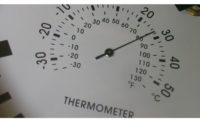
Inside The Unit
High return gas temperatures and/or low suction pressures can raise cylinder temperatures extremely high, even up to 325 degrees F. At these temperatures or even a little bit lower (310 degrees F), the lubricating film evaporates clean off the cylinder walls - like water on a hot griddle. Signs of overheating may include discolored valve plates and reeds, possible cylinder and ring wear, wrist pin assembly wear, and under extreme conditions, lower-end damage such as worn or seized bearings and worn or broken connecting rods.What causes it? For a variety of reasons such as those stated above, temperatures in the compressor head and cylinders become so hot that the oil loses its ability to lubricate properly. This causes rings, pistons, and cylinders to wear, resulting in blow by, leaking valves, and metal debris in the oil.
Note: Modern refrigeration oils have been engineered so that they don't break down easily. Therefore, carbon may not form on the valve plate in an overheated compressor. You just don't see the cooked-on, blackened, caked-on oil that you might have with older oils. As a result, it's easier to misdiagnose a high-temperature failure as a liquid failure. The broken rods and debris may look suspiciously like a slugging incident. However, a broken rod caused by a slug is usually a very clean break. If a rod is broken from overheating, you should see extensive wear. You can also see extreme ring or piston wear in an overheat failure, though with little oil carbonization. In short, it is important to look for signs of scoring and metal debris in the oil.
Discharge, Airflow, And Suction
High discharge temperatures: For a good long life, piston, ring, and valve port temperatures should be maintained below 300 degrees. Normally discharge line temperatures within 6 inches of the compressor outlet will be 50 degrees to 75 degrees cooler than cylinder and piston temperatures, depending on the compressor design and the refrigerant mass flow. Generally, if discharge line temperatures reach 275 degrees, you're looking at a certain-failure temperature condition; 250 degrees is a danger level. You need to maintain 225 degrees and below for reasonable life expectancy.One solution in low-temperature applications is to insulate the suction line, so that you can keep the return gas from picking up any additional heat outside the cooled space. Measuring the compressor's superheat is important; if it is high, this may reflect in high discharge temperatures.
Proper airflow: Airflow across the compressor can be key to maintaining lower discharge temperatures. Is there proper airflow across the compressor? Has the condenser cooling fan been cycled so that the compressor is not receiving adequate airflow? Especially at low-temperature operating conditions, the decreased density of the refrigerant vapor and the heating effect of high compression ratios combine to create high discharge temperatures. These cannot be controlled by refrigerant cooling alone. In order to survive, the compressor needs a direct air blast. Any decrease in the recommended airflow, or loss of direct airflow on the compressor, can rapidly lead to excessive cylinder temperatures and compressor death due to overheating.
Low suction temperatures: If the suction pressure is too low, it will cause discharge temperatures to be elevated. As suction pressure is lowered the heat of compression goes up. The heat of compression is the heat generated in the cylinders by compressing the vapor.
As far as compressor overheating is concerned, it's the suction pressure at the compressor that is critical, not the case evaporating temperature. In many cases the critical threat is caused by pressure drop between the case and the compressor.
Externally, failures caused by overheating can appear similar to those caused by floodback. It's important to open a few units up so that you can see what actually happened. It's just as important to know what you're looking for, and how to decipher what you see ... and what you don't see.
For more information, click on the Emerson Climate Technologies logo above.



